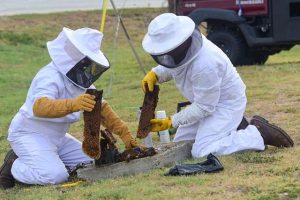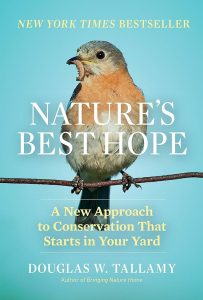4.2 Roles of Native Species
By now, you should know that ecosystems are intricately connected and rely on each other to function properly. Native species play a crucial role in maintaining this balance. Let’s explore a few of the key roles that native species play in ecosystems:
Food Chains
Native species are essential components of local food chains. Plants (primary producers) convert sunlight into energy through photosynthesis, forming the base of the food chain. Herbivores (primary consumers), such as insects, feed on these plants. These herbivores are then preyed upon by carnivores and omnivores (secondary consumers), which may then be eaten by other carnivores or omnivores (tertiary consumers). That means that the producers ultimately create all of the energy in the ecosystem, and that energy is simply transferred from one organism to another in the food chain.
Because of coevolution, native insects have adapted to feed on native plants. Many non-native plants are not suitable food sources for native insects, which results in fewer insects. Having fewer insects around might seem like a good thing, but fewer insects means that there is less food available for the upper levels of the food chain, resulting in fewer birds, mammals and other species of wildlife. In other words, a decrease in native plants leads to a decrease in overall biodiversity.

Pollination
Pollinators play a critical role in the reproductive processes of many plants by transferring pollen from one flower to another. Native insects pollinate our native plants but are also crucial pollinators for our agricultural crops to help increase the yield and quality of our produce.
Seed Dispersal
Many native animals help disperse seeds, aiding in plant reproduction and the spread of vegetation. Many bird species feed on fruits and berries of native plants and then disperse seeds through their droppings as they move from one location to another. Small mammals like squirrels and chipmunks transport seeds to new locations as they bury them for storage. Even ants help with seed dispersal. Certain native plants have specialized seeds with lipid-rich components called elaiosomes. Ants are attracted to these elaiosomes, collect the seeds, and disperse them to their underground nests. This mutualistic relationship benefits both the plants (through seed dispersal) and the ants (through food).
Pest Control

Native species often include predators and parasitoids that naturally regulate pest populations. These organisms have evolved alongside their prey or host species, developing specialized adaptations and behaviours that make them effective at controlling pest populations. When native predator populations are healthy and diverse, they can prevent pest outbreaks by feeding on pest species to maintain a balance within the ecosystem. This reduces the need for human intervention with chemical pesticides.
Keystone Species
Some native species act as keystone species in their ecosystems. Keystone species are those that have a disproportionately large impact on their environment relative to their abundance. They play a critical role in maintaining the structure of an ecosystem (Climate Adaptation Explorer, n.d.). The loss of a keystone species can lead to significant changes and potential collapse of the ecosystem.
Certain native plants are keystone species because they support a wide variety of insect herbivores, which in turn support higher trophic levels, including birds and mammals. For example, oak trees are keystone plants in our region. Oaks are host plants that feed the caterpillars of 436 species of butterflies and moths (Lepidoptera), more than any other plant. To compare, some non-native plants, like ginkgo trees (Ginkgo biloba), only support one species of caterpillar. Caterpillars are needed in our ecosystems because they are a crucial food source for other wildlife. 96% of birds require caterpillars to feed their young (National Wildlife Federation, n.d.). For some species, parents must catch over 6000 caterpillars to feed the babies in one clutch!
This again shows the intricate connections within our ecosystems. Without oaks, we won’t have as many caterpillars, which in turn leads to fewer birds, and the effects ripple throughout the entire ecosystem. This is particularly concerning given the looming threat of oak wilt in Southwestern Ontario. Check out Oak Wilt in Chapter 5.4 Invasive Species in London to learn more.
A Closer Look

Globally, insect populations are declining at alarming rates.
Douglas Tallamy, an entomologist and ecologist, advocates for the use of native plants in landscaping to support insects and help increase biodiversity.
You can learn more about Tallamy’s work in his book:
Nature’s Best Hope: A New Approach to Conservation That Starts in Your Yard
Consider enhancing biodiversity in your own yard by incorporating some native plants. Check out these resources to get started:
Reflection
Do you like bugs?
Insects have a bad reputation. Popular media portrays them as creepy, dangerous, or dirty. Some people fear them because of their unfamiliar features like antennae and multiple legs. Others associate insects with past negative experiences like mosquito bites or bee stings. Most people only see bugs as nuisances or threats but overlook the good that they do. They are vital in pollination, decomposition, and as a part of the food web. Understanding their ecological importance can help shift perspectives.
So I ask again, do you like bugs?
Let’s work to appreciate insects and abandon our irrational fears and prejudices.

